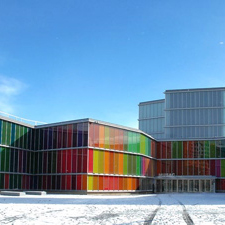The MUSAC Contemporary Art Museum of Castilla y León, Spain, by architects Mansilla + Tuñón has won the Mies van der Rohe Award 2007 (via dezain, via Archinect).
The award, subtitled the European Union Prize for Contemporary Architecture, is granted every two years by the European Union and the Fundació Mies van der Rohe, Barcelona, to acknowledge and reward quality architectural production in Europe.
See the list of other winners here.
Below is a citation on the winning project from the award jury:
--
Awarded Work
MUSAC – Museo de arte contemporáneo de Castilla y León (Contemporary Art Museum of Castilla y León ), León, España ,
Luis M. Mansilla, Emilio Tuñón Mansilla + Tuñón
On a vast urban plan, MUSAC draws the scenario for art with the same optimistic attitude used by the Roman surveyors to sketch their cities in the landscape.
In contrast to other types of museums that focus on the exhibition of frozen historic collections, MUSAC is a living space that opens its doors to the wide-ranging manifestations of contemporary art.
This is an art centre that constructs a set of chessboards on which the action is the protagonist of the space; a structure that develops from an open system, formed by a fabric of squares and rhombi, and permitting the construction of a secret geography of memory.
MUSAC is a new space for culture, regarded as something that visualises the connections between man and nature. A cluster of chained but independent rooms permit exhibitions of differing sizes and types.
Each of the jaggedly shaped rooms constructs a continuous yet spatially differentiated area that opens onto the other rooms and courtyards, providing longitudinal, transversal and diagonal views. Five hundred prefab beams enclose a series of spaces that feature systematic repetition and formal expressiveness.
Outside, the public space takes on a concave shape to hold the activities and encounters, embraced by large coloured glass in homage to the city as the place for interpersonal relationships.
Inside, a large area of continuous, different spaces, spattered with courtyards and large skylights, shapes an expressive system that speaks to us of the interest shared by architecture and art: the contemporary manifestation of the variable and the perennial, of equality and difference, of universality and transience, an echo of our own diversity and equality as people.
In its size, as a single-storey building with white concrete walls and large coloured glazing seen from the outside, MUSAC strives to be a space where art is at ease and helps to erase the boundaries between private and public; between work and leisure; and between art and life.

